Written by: Ruth D’Alessandro
Fact Checked by: Laura Harding
Employee engagement describes the quality of an employee’s relationship with their employer. It’s both emotional and attitudinal and describes how employees feel about working; whether they personally identify with their organization; and how much effort they want to put in on their employer’s behalf.
Qualtrics research found that employers care about improving employee engagement because it predicts their organization’s future performance. The more engaged employees are, the higher the discretionary effort they put in.
It takes more than one bad or good day to influence how engaged someone is with their work. Rather, the cumulative effects of daily employee experiences drive engagement – or disengagement.
Employee experience (EX) is the sum total of those experiences and relates to cultural, technological and physical environments at work, i.e. everything an employee encounters, observes and feels while doing their job.
And employee experience has ramifications beyond engaging employees. Done well, it drives better business outcomes, delivers customer satisfaction, and supports happy, healthy employees who feel that they belong.
So, employee engagement is a huge deal for employers. Which is why it needs to be measured with a framework of best practice, so that EX metrics can sit alongside your customer and brand metrics.
What is an employee engagement model?
An employee engagement model is a framework organizations use to make sure their employees are happy, safe, healthy, valued, supported – and engaged. Such a model ensures that employees are treated as human beings first and foremost, with lives beyond work. And when business becomes more human, guess what? Valued and appreciated employees are more productive, and less likely to leave their jobs.
An employee engagement model measures engagement in a scientifically validated way. Because when something can be measured, it can be analyzed, then actions taken to improve lacking areas.
Free eBook: The rise of people teams as a business growth driver
Why it’s important to have an employee engagement model
Stats from Gallup say it all, really:
- Highly engaged employees result in a 23% increase in profitability
- Engaged employees reduce absenteeism by 41%
- Businesses that engage employees actively see an 18% decrease in staff turnover
- Highly engaged businesses achieve 59% less turnover
BUT…
85% of employees are not actively engaged or (are) actively disengaged at work.
That’s a massive experience gap between what can be achieved with an engaged workforce, yet how many workforces have disengaged employees.
Every employer needs an employee engagement strategy and at the heart of it must be an employee engagement framework. The framework will guide how you gather feedback from your employees, what you need to explore, and the action planning required to act on the resulting data.
5 popular employee engagement models
You don’t have to start with a blank page when you come to develop your employee engagement model. There are several popular, tried-and-tested employee engagement theories with frameworks out there to help you measure engagement and recommend how to act on the results.
It’s important to use tried and tested models because they are based on best practice, and have been validated. They also give organizations peace of mind that the questions they are asking are actually measuring the metrics they want to understand and improve.
These models usually come with benchmarks, so one organization can understand how their performance compares to similar organizations.
1. Qualtrics EX25 model
Qualtrics sees engagement as part of a wider EX (employee experience) picture. That’s why they developed their own employee engagement model – EX25.
Rather than looking at engagement as a single metric, EX25 uses a series of new key performance indicators (KPIs) to simplify and break down engagement.
This new framework empowers leaders to understand more about the employee experience beyond just engagement by taking a more holistic approach – through new dimensions of engagement, such as:
- Well-being
- Experience vs Expectations
- Intent to Stay
- Inclusion
Furthermore, EX25 highlights the 25 most critical drivers of these KPIs, each with its own levers:
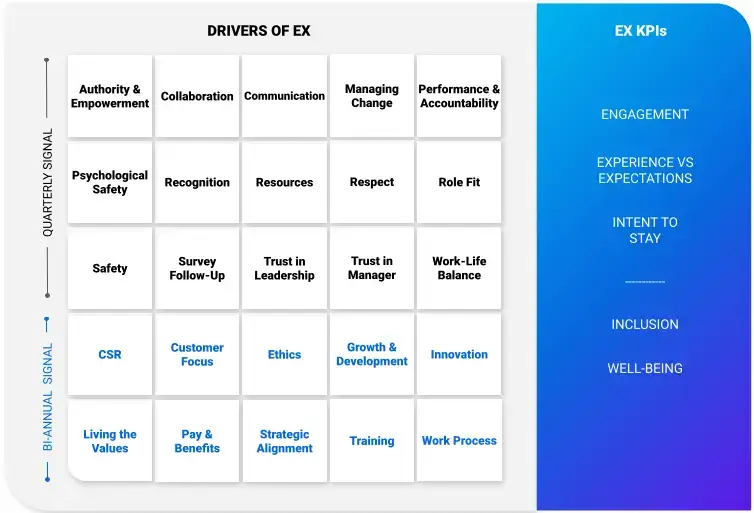
Leveraging years of client research and global validation studies, EX25 is an industry-leading approach to measuring and optimizing employee experience.
2. The Zinger model of employee engagement
David Zinger is a Canadian psychologist who loves taking evidence and research-based insights and transforming them into practical, down-to-earth ideas for organizations.
His Zinger employee engagement theory model is a pyramid that’s based on core employee needs. That foundation needs laying before moving onto the second row, the third row, and finally the apex of the pyramid – ‘getting results’:
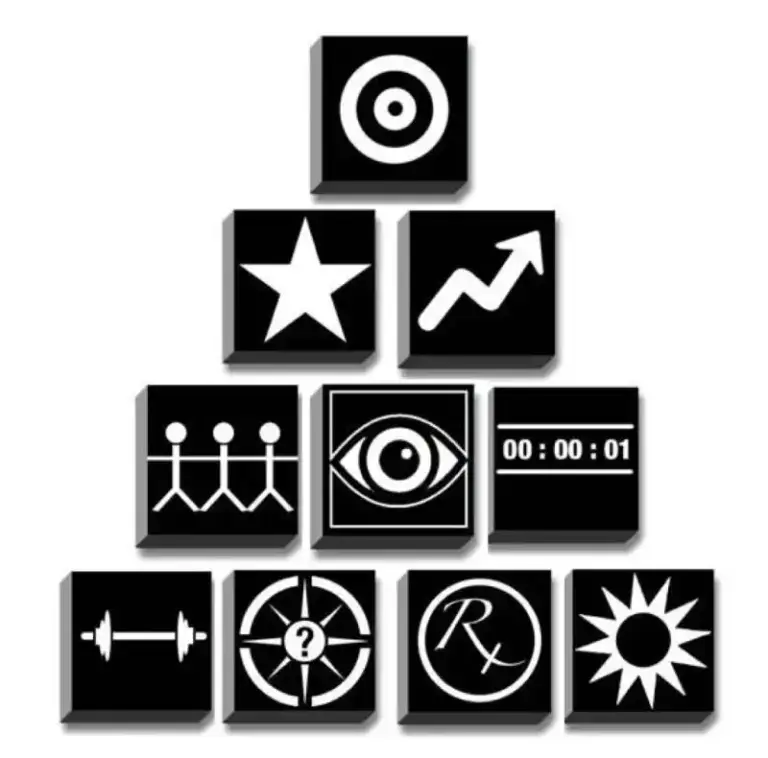
Image: https://www.linkedin.com/posts/davidzinger
The bottom row of the Zinger model represents the basic essentials that everyone needs to do a good job at work. These are: (L-R)
Use strengths
Exercise, grow and develop the existing strengths of each individual employee.
Create meaning
Employees need purpose to their work to be fully engaged.
Increase wellbeing
Employees need to be mentally and physically healthy, and feel psychologically safe in order to do their best work.
Energize
Make sure the work environment and management energizes employees, rather than draining them.
The middle row then builds upon how to connect employees to their organization. From L-R:
Build relationships
Managers and leaders must promote authentic, meaningful workplace relationships so team members like each other.
Promote recognition
Praise effort and reward a job well done as part of an ongoing recognition culture, rather than the occasional performance review.
Master moments
Keep employees interested with daily, engaging, useful touchpoints – interactions that deepen connections, ask for input and identify obstacles.
The third row is all about giving performance a boost:
Maximize performance
Look at blocks, barriers and obstacles that may be preventing employees from doing their best work and reaching their goals.
Track progress
Track and communicate progress and feed it back to employees often, to keep them engaged, with a sense of momentum and achievement.
Top block:
Get results
Employees are fully engaged and productive, and contributing to business outcomes.
3. The Deloitte model
The Deloitte model of employee engagement, developed by one of the one of the world’s Big Four accounting firms, centers around the idea of making a workplace ‘irresistible’.
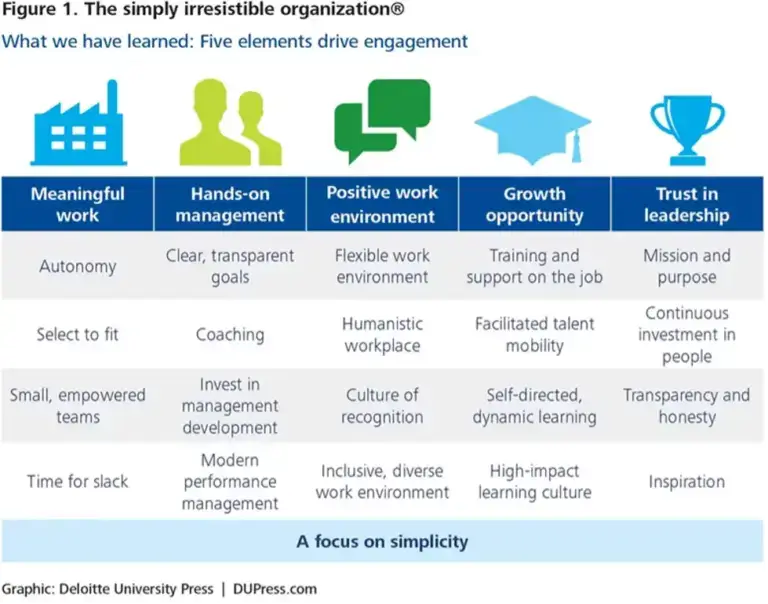
Image: https://www2.deloitte.com
It identifies five core elements of engagement, and within each element are four features that make fulfilling the essence of that element possible:
Meaningful work
Choosing the right person for the job, letting them get on with it in small teams and giving them breathing space.
Hands-on management
Leaders must be trained, skilled managers who give clear direction and regular coaching
A positive work environment
A workplace that’s diverse and inclusive, where employees are treated as people, and are recognized for their work and contributions.
Opportunity for growth
Employees must be able to grow, develop and progress, both by self-directed learning and more formal on-the-job-training.
Trust in leadership
Organizations must have integrity, transparency and a social conscience, as well as a purpose and mission that employees can be proud of.
Get all these right, and keep things simple, infers Deloitte, and employees won’t be able to resist coming into work every day.
4. The Aon Hewitt model
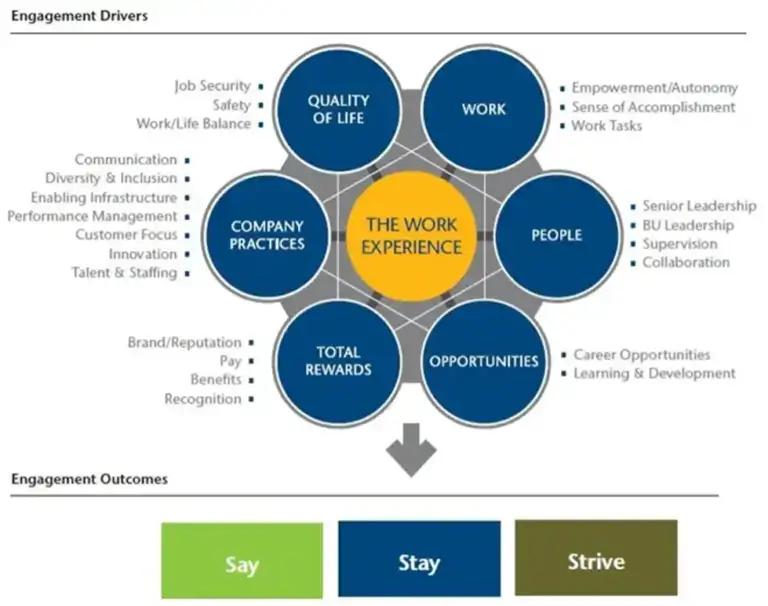
Image: https://hohmannchris.wordpress.com
The Aon Hewitt model proposes that engaged employees will do three things:
- Say: good things about their organization to other people
- Stay: will intend to remain in their organization
- Strive: will work to the best of their ability and put in discretionary effort
What drives them to deliver these three engagement outcomes are six elements of The Work Experience:
Quality of life
Feeling safe, with job security and work life balance.
Work
Being able to get on with the job and accomplish tasks, unimpeded.
People
Being well managed, supervised and able to collaborate with others.
Opportunities
The chance to grow, develop and advance in a career.
Total Rewards
Being recognized, rewarded fairly, and working for a respected organization.
Company practices
How well the company handles its various departments and functions.
5. The Gallup employee engagement model
Gallup’s model has four levels. The idea is that the three foundational levels develop trust, support and performance that then allow managers and employees to get the most out of the top level – growth.
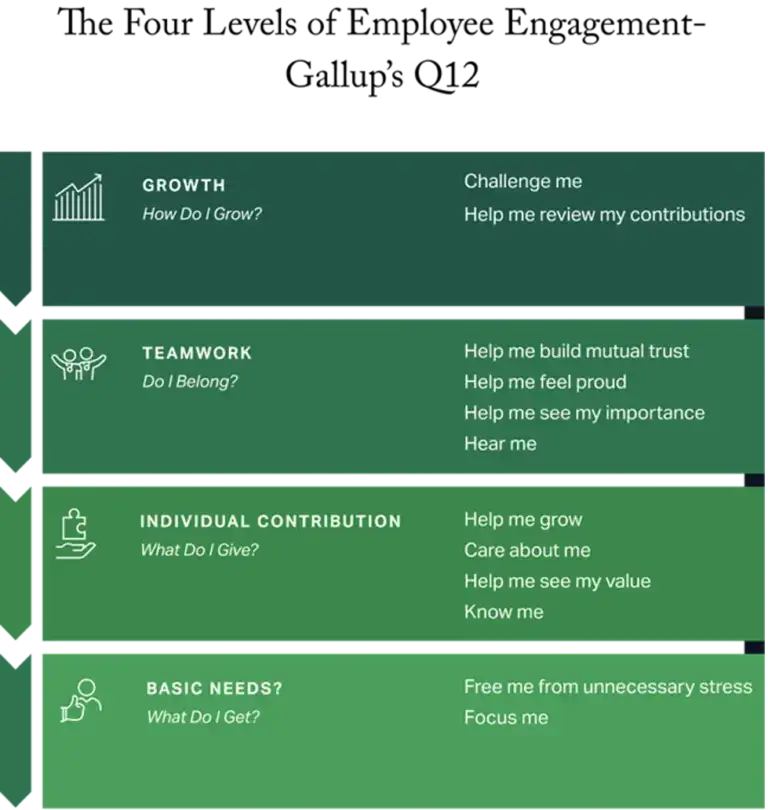
Image: https://www.gallup.com/
And to evaluate engagement, the Gallup model asks the following questions in a survey:
- How satisfied are you with your company as a place to work?
- I know what is expected of me at work.
- I have the materials and equipment I need to do my work right
- At work, I have the opportunity to do what I do best every day.
- In the last seven days, I have received recognition or praise for doing good work.
- My supervisor, or someone at work, seems to care about me as a person.
- There is someone at work who encourages my development.
- At work, my opinions seem to count.
- The mission or purpose of my company makes me feel my job is important.
- My associates or fellow employees are committed to doing quality work.
- I have a best friend at work.
- In the last six months, someone at work has talked to me about my progress.
- This last year, I have had opportunities at work to learn and grow.
The answers then feed into the model’s four levels to give a measure of engagement.
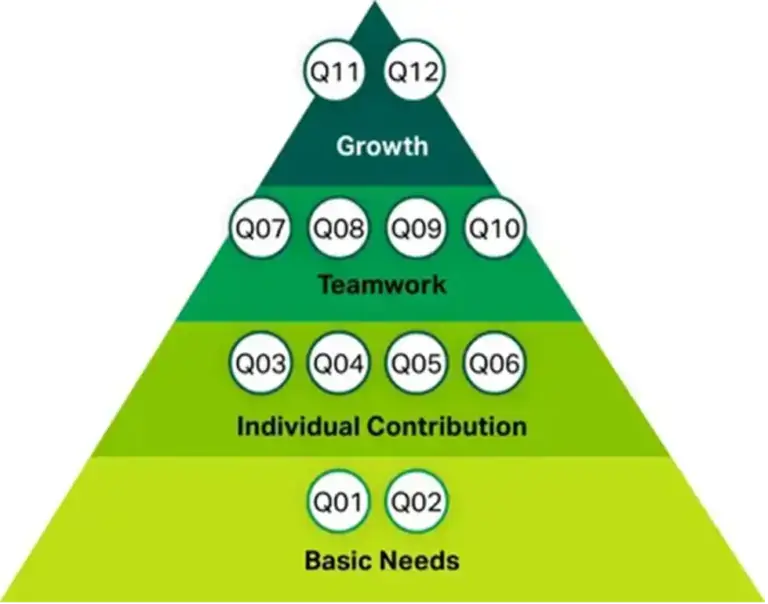
Image: https://www.gallup.com/
How Qualtrics® can help with your employee engagement model
With Qualtrics, you’ll be able to go beyond engagement and create great employee experiences. When you use our holistic and easy-to-use employee experience software, everyone – from new employees and frontline workers, to managers and the CEO – can make their voices heard.
It’s the ultimate listening tool for gathering continuous feedback from every employee. You’ll be able to take the right actions to improve employee engagement, recognition, talent planning, productivity and innovation.
Powered by AI and automation, Qualtrics People Teams lets you continually listen to employee feedback and get a holistic view of every touchpoint in the employee lifecycle.
It includes:
- employee engagement listening – to hear every experience
- employee engagement analytics – to automatically uncover the most acute experience gaps
- employee engagement action planning – to make the process of taking action on employee feedback successful at scale.
- Manager Assist™ – to help managers build stronger teams
Get to the heart of what your people care about and build world-class employee experiences.
Free eBook: The rise of people teams as a business growth driver